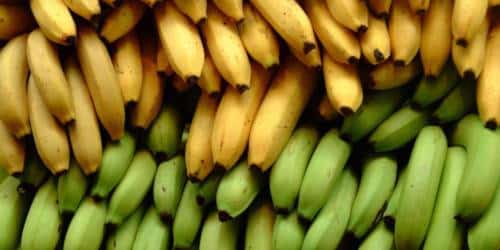Banana farming is a frequent and popular enterprise all around the world. It is a delicious and nutritious fruit that is available all year. Commercial banana production is one of many people’s main traditional occupations. The following article discusses Banana Farming Techniques, Banana Planting Methods, Banana Plant Care, and Harvesting Techniques. Let’s get started!
What is a Banana?
The banana is a tropical fruit that grows around the world, including Nigeria and Africa. There are multiple species in the genus Musa. Musa acuminata, the species utilized for commercial banana production, is the most frequent. When ripe, the fruit is elongated with yellow, green, or red skin and soft, sweet, white, or yellow flesh. Bananas are high in nutrients such as potassium, vitamin C, and dietary fiber.
The fruit can be eaten raw as a snack or used to make banana chips, bread, and smoothies. Banana farming is an important business in many regions of Nigeria and Africa since it provides a strong source of revenue for farmers while also contributing to the region’s food security.
What Is Banana Farming In Nigeria?
Banana farming is the commercial cultivation of banana crops. Bananas are tropical trees that produce fruit that is high in carbs, vitamins, and minerals. They are one of the world’s most significant crops, serving as both a food source and a major export item.
Banana farming entails establishing and caring for banana trees, controlling pests and diseases, and harvesting and processing the fruit for sale. The crop is farmed all throughout the world, especially in Africa, and provides a significant source of money and food for many people. Banana farming is a large agricultural activity in Nigeria and Africa that provides great prospects for economic growth and food security.
Advantages of Banana Farming
Commercial banana farming is a fairly prevalent and well-known enterprise all over the world. It is so simple that even beginners can start this company.
Profits can also be made through this enterprise. Among the many advantages of the banana farming industry are:
- Commercial banana farming is quite lucrative. This company will allow you to make a lot of money.
- It is a well-established industry, and many people are already profiting from it.
- Banana plants thrive in practically every country on the planet. And taking care of the plants is really straightforward.
- Bananas are in high demand and have a high price.
- Commercial production is extremely lucrative. As a result, it may be a good source of employment. Especially for educated unemployed individuals.
- Commercial banana farming, like other agribusinesses, does not necessitate a large investment.
- And you will shortly receive your investment money back.
- Marketing bananas is simple since bananas have a well-established global market.
- Consuming bananas on a regular basis is extremely beneficial to one’s health. You can also enjoy fresh bananas if you create your own producing company.
Health Benefits of Bananas
Bananas are a high-nutritional-value fruit with several health benefits. The following are 15 health benefits of bananas for the body:
- Blood pressure regulation: Bananas are high in potassium, which aids in blood pressure regulation.
- Boosts energy levels: Increases energy levels: Bananas are high in carbs, which offer energy.
- Encourages good digestion: Bananas are high in fiber, which assists digestion and prevents constipation.
- Enhances brain function: Bananas include vitamin B6, which aids in the improvement of brain function and cognitive capacities.
- Helps fight depression: Bananas contain tryptophan, which helps increase serotonin levels and alleviate depressive symptoms.
- Supports heart health: Bananas are high in fiber, potassium, and vitamin C, all of which are beneficial to heart health.
- Reduces inflammation: Bananas have anti-inflammatory chemicals that can help reduce inflammation in the body.
- Aids in weight loss: Bananas are low in calories and high in fiber, making them an excellent item to include in a weight loss regimen.
How to Start Banana Farming Business
Starting a banana farming business in Nigeria or Africa can be a lucrative investment if the proper measures are done. A step-by-step method to beginning a banana farming business is provided below:
#1. Select Good Location
First and foremost, you must choose an excellent site for your new venture. Banana plants thrive in fertile, well-drained soil.
Banana plants may thrive in a wide range of soil conditions. They may live in a variety of soil types ranging from poor to rich, including deep silty, clay, loam, and rich loamy soil. A pH range of 6.7 to 7.5 is considered suitable for commercial banana cultivation.
If your existing land is acceptable for this enterprise, you can use it. Soils high in nitrogen, phosphate, and potassium are ideal for banana growing.
#2. Prepare the Soil
It is also critical to properly prepare the soil. Before planting banana plants, you must prepare the land.
In the summer, plow the field thoroughly at least 3-4 times. At the time of the last plowing, apply a suitable amount of organic fertilizer.
The earth should then be leveled. Before planting, mix nematicides and fumigants into the soil, especially if you live in a nematode-infested area.
#3. Climate Requirements For Banana Farming
The banana is a tropical crop. It grows well in temperatures ranging from 15oC to 35oC with relative humidity levels ranging from 75% to 85%.
Banana plants prefer damp tropical lowlands. However, with the right cultivars, they may be grown in temperatures ranging from humid tropical to dry mild subtropical.
Wind speeds exceeding 80 kilometers per hour harm the crop. And chilling harm happens when the temperature falls below 12oC. The monsoon season (June to September) with an average of 650 to 750 mm rainfall is critical for the banana plants’ rapid vegetative growth.
#4. Choose a Variety
There are numerous banana kinds available around the world. You can select any of them depending on their availability in your area. You can get some solid tips from local farmers.
Cavendish, Pisang Raja, Red, Lady Finger, Blue Java, Plantain, Manzano, Burro, Barangan, and Goldfinger are the top ten banana varieties.
#5. Purchase Plants
Banana plants are not grown from seeds, but rather from suckers used as planting material. In some cases, tissue culture seedlings are also employed.
In nurseries, little plants are readily available. You can easily buy from any of your local nurseries or farmers who sell plants. If 1.81.5m spacing is used, approximately 1452 plants fit per acre. One acre can hold 800 plants with a spacing of 2mx2.5m.
#6. Planting
Prepare the land using the method outlined above in the section on land preparation. The smaller plants can then be planted.
The pit planting method is commonly employed in the garden cultivation system. A pit measuring 45cm x 45cm x 45cm will suffice. Fill the pits with dirt mixed with 10kg of well-decomposed farm yard manure, 250g of neem cake, and 20g of carbofuran.
Before refilling, leave the pits open for 15 to 20 days to allow solar radiation to kill all insects, and soil-borne diseases, and allow for aeration. Avoid deep planting by placing the suckers in the center of the pit and softly pressing the soil around them.
#7. Caring
Banana plants grow well in general and require little attention. Taking extra care, on the other hand, will help the plants develop and produce better. Caring for them is simple; even beginners can do it. Some examples are:
- Fertilizing: Banana plants, in general, require a lot of nutrients. While preparing the soil, incorporate as much organic matter as possible. Additional fertilizer application is also required. For better recommendations based on soil tests, consult an expert in your area or your local agriculture extension office.
- Watering: Because the banana is a shallow-rooted crop, it necessitates a substantial amount of water to increase productivity. In general, for excellent production, the plants require 70 to 75 percent watering. In the winter, provide watering every 7 to 8 days. During the summer, apply irrigation every 4 to 5 days. During the rainy season, no irrigation is required.
- Mulching: Mulching is an excellent method for conserving soil moisture. It is also useful for weed management. Organic materials, such as mulch, can be used.
- Weeding: Regular weeding is critical for a successful commercial banana farming enterprise. Weeds deplete soil nutrients, causing your plants to suffer. Controlling them is therefore critical.
- Propping: Because of the heavy weight, the plants go out of balance, and the fruit-bearing plant may lodge, reducing production quality.
#8. Harvesting
Banana plants develop quite quickly, and the crop is ready to harvest 11 to 12 months after planting. Begin harvesting when the bananas are partially or totally grown, or when the market demands it.
Harvest the fruits at the maturity stage for the local market, and at 75% to 80% maturity for long-distance shipment.
However, for export purposes, begin harvesting the day before or on the day of shipment. In the summer, harvest fruit early in the day, while in the winter, avoid harvesting too early in the morning.
#9. Yield
The precise amount cannot be determined. It is determined by a variety of circumstances. Around or up to 50 tons per acre are possible.
#10. Marketing
It is really simple to sell bananas. Bananas are in high demand and have a high market value. I hope you will be able to sell your products easily in the local market.
Target Market For The Banana Farming Business In Nigeria
As a banana farmer, you can sell or promote your bananas at the following prominent locations:
- Local Markets: Bananas are a popular fruit in Nigeria and Africa, with a sizable local market accessible via wholesale markets and retail outlets.
- Export Markets: The international banana market is expanding, and Nigeria and Africa have the opportunity to enhance their exports to other countries. This encompasses European, Asian, and Middle Eastern markets.
- Food Processing Industries: Bananas can be used as a raw material in food processing industries such as bakeries, confectioneries, and ice cream factories, which require huge numbers of bananas for manufacturing.
- Smoothie/Juice Bars: Bananas are often used in smoothies and juices, and the market for these goods is expanding throughout Nigeria and Africa, particularly in metropolitan areas.
- Pharmaceutical Industries: Bananas have medicinal characteristics, and their extracts are used to make a variety of medications. Pharmaceutical businesses are a potential market for bananas, particularly organic bananas.
Is Banana Farming Profitable?
Yes, commercial banana production is an extremely profitable enterprise. You can start commercial banana production to make a lot of money.
How Long Does it Take to Grow Banana?
Banana plants develop at a higher rate than many other trees. Plants typically take 10 to 15 months to mature after planting.
What is the Best Month to Plant Banana?
Banana plants can actually be grown all year round (unless during severe winters and heavy rains). The months of October and November are considered excellent for planting banana trees. However, you can sow these plants with guaranteed irrigation in February and March.
How Long Does it Take for Banana to Bear Fruit?
The following year’s crop of bananas will be the first to be harvested. However, the exact period it takes for the plant to bear fruit is dependent on a variety of environmental factors. If you provide perfect growing circumstances for the plants, they will develop fruits sooner.
How Do You Farm Bananas?
Banana farming is straightforward and easy because these plants require little care and attention. The soil in commercial banana production should have a strong drainage system, appropriate fertility, and moisture. Banana production benefits best from deep, rich loamy soil with an optimal pH between 6 and 7.
Do Banana Trees Need a Lot of Water?
Yes, banana plants demand a lot of water and must be watered on a regular basis. They require a lot of water to keep the huge tropical leaves and sweet, delectable fruits alive. During the warmer months, commercial producers must water the plants every 2 to 3 days.
Conclusion
Finally, banana farming is a viable agricultural endeavor in Nigeria and Africa, with several potentials for revenue production, job creation, and economic progress. However, success necessitates a tremendous investment of time, resources, and experience.
Disease, insect infestation, and harsh weather conditions can all pose substantial obstacles, but they can be mitigated with proper planning and management.
Related Articles
- Dates Farming: Best Beginners Guide 2023
- Bakery business plan (Download + 3 years free financials)
- MANUFACTURING PLANT: What Is It, Examples & What You Need to Know
- Wheat Farming In Nigeria: All You Need To Know
- HARVEST TIME TRACKER: Harvest Software Reviews & Pricing 2023






